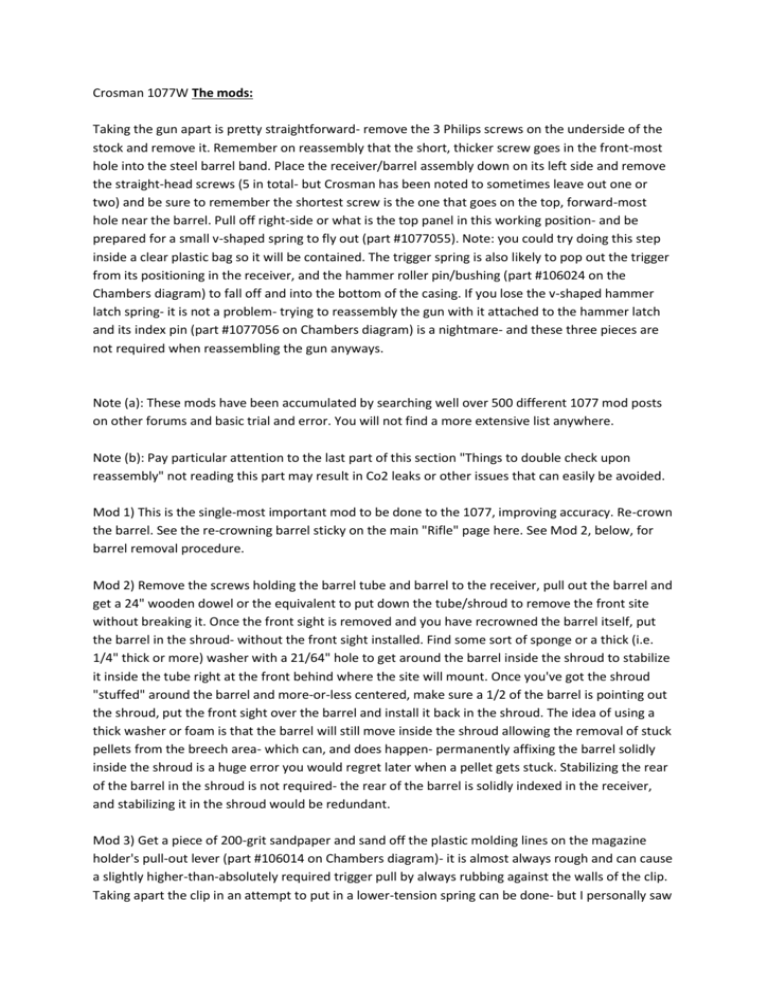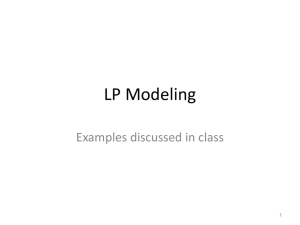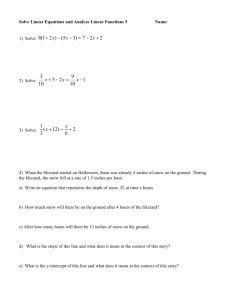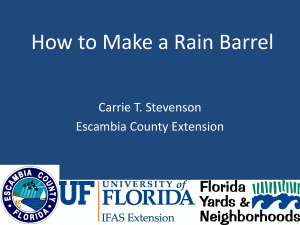Crosman 1077W The mods: Taking the gun apart is pretty
advertisement

Crosman 1077W The mods: Taking the gun apart is pretty straightforward- remove the 3 Philips screws on the underside of the stock and remove it. Remember on reassembly that the short, thicker screw goes in the front-most hole into the steel barrel band. Place the receiver/barrel assembly down on its left side and remove the straight-head screws (5 in total- but Crosman has been noted to sometimes leave out one or two) and be sure to remember the shortest screw is the one that goes on the top, forward-most hole near the barrel. Pull off right-side or what is the top panel in this working position- and be prepared for a small v-shaped spring to fly out (part #1077055). Note: you could try doing this step inside a clear plastic bag so it will be contained. The trigger spring is also likely to pop out the trigger from its positioning in the receiver, and the hammer roller pin/bushing (part #106024 on the Chambers diagram) to fall off and into the bottom of the casing. If you lose the v-shaped hammer latch spring- it is not a problem- trying to reassembly the gun with it attached to the hammer latch and its index pin (part #1077056 on Chambers diagram) is a nightmare- and these three pieces are not required when reassembling the gun anyways. Note (a): These mods have been accumulated by searching well over 500 different 1077 mod posts on other forums and basic trial and error. You will not find a more extensive list anywhere. Note (b): Pay particular attention to the last part of this section "Things to double check upon reassembly" not reading this part may result in Co2 leaks or other issues that can easily be avoided. Mod 1) This is the single-most important mod to be done to the 1077, improving accuracy. Re-crown the barrel. See the re-crowning barrel sticky on the main "Rifle" page here. See Mod 2, below, for barrel removal procedure. Mod 2) Remove the screws holding the barrel tube and barrel to the receiver, pull out the barrel and get a 24" wooden dowel or the equivalent to put down the tube/shroud to remove the front site without breaking it. Once the front sight is removed and you have recrowned the barrel itself, put the barrel in the shroud- without the front sight installed. Find some sort of sponge or a thick (i.e. 1/4" thick or more) washer with a 21/64" hole to get around the barrel inside the shroud to stabilize it inside the tube right at the front behind where the site will mount. Once you've got the shroud "stuffed" around the barrel and more-or-less centered, make sure a 1/2 of the barrel is pointing out the shroud, put the front sight over the barrel and install it back in the shroud. The idea of using a thick washer or foam is that the barrel will still move inside the shroud allowing the removal of stuck pellets from the breech area- which can, and does happen- permanently affixing the barrel solidly inside the shroud is a huge error you would regret later when a pellet gets stuck. Stabilizing the rear of the barrel in the shroud is not required- the rear of the barrel is solidly indexed in the receiver, and stabilizing it in the shroud would be redundant. Mod 3) Get a piece of 200-grit sandpaper and sand off the plastic molding lines on the magazine holder's pull-out lever (part #106014 on Chambers diagram)- it is almost always rough and can cause a slightly higher-than-absolutely required trigger pull by always rubbing against the walls of the clip. Taking apart the clip in an attempt to put in a lower-tension spring can be done- but I personally saw no improvement in trigger pull as a result. Mod 4) Replace the trigger spring (part #1077-014 on the Chambers diagram) with one a bit shorter and not as strong- this will help ease trigger pull. Some people have put a (very) small screw through the rear plastic stop for the spring so it doesn't pop out as easily when gun is disassembled- if you plan to do this, be sure to use a drill to create a hole for the screw first- just screwing something through will guarantee it breaking. Mod 5) Polish breech end of barrel (rear) so it seals to front of pellet magazine as well as possible. If you have the equipment and tools- you could also install a larger 'umbrella' on the rear of the barrel to ensure accurate pellet loading- but this is generally not required. Mod #5- the "umbrella" I've mentioned might be more accurately described as a tall 'top hat'- the idea being that what would be called the brim on the hat (the horizontal, flat surrounding part) would be at the rear of the barrel and its cylindrical part would be curved/cut to start out slightly larger than .177" down to .177" and be part of the barrel opening. I don't have a picture of this, unfortunately, but the idea is that it would, theoretically, aid in pellet movement from the magazine into the barrel and help ensure a maximum amount of Co2 is directed behind the pelletnot escape between the back of the pellet and the magazine. That being said, even if it stopped 75% of all pellet jams that occur- how many pellet jams occur usually? Very few typically. And how much Co2 escapes from between the magazine and barrel end- not very much as I can tell- so this mod is probably a huge time expense for little real gain, and just polishing up the barrel end a bit is alot easier and might gain a bit in respect to Co2 retention. Mod 6) Disassemble the valve completely, and polish the stem's front bolt, rear pin, and seat areas (part #106002). You will need a inside lock ring pliers to remove the retaining ring to get to this/these parts. Mod 7) Install a seal around the inside circumference of the valve housing (rear of part #1077A016the housing behind the lock ring and around the valve stem). It needs to be a thin seal so it doesn't interfere with hammer travel and have a large enough hole for the valve stem end of come through without restriction. This seal may be an appropriate sized plumbing flat washer, or just about anything you can dream up- even glueing all around the lock ring would work- but good luck ever taking the valve stem out again. Mod 8) The black (standard valve) or grey (detuned valve) spring-loaded assembly (the 'detent body') at the front of the valve (#106A010 on Chambers diagram). Install a stronger spring, and add an O-ring into the obvious slot on the outside rim the plunger (#106B036). Make sure the O-ring you install doesn't bog the plunger- but seals it somewhat. Lubricate with Crosman Pelgunoil or 100% silicone lube through the plunger hole every few hundred shots, or by putting the same on the piercing pin hole in the feed tube (it will eventually find its way through the Co2 plumbing to the valve detent)- whichever is easier for you. The idea with these mods is to seal and put as much pressure behind the detent plunger so that Co2 can come back or leak out instead of getting through the plunger hole and to the rear of the pellet, but still allow clips/magazines to be installed without prematurely wearing out the plunger (i.e. some movement of the plunger needs to be present). Note: For a "gray" or detuned valve detent assembly- the hole in the plunger is smaller than on a standard valve detent- it can be drilled out to the same diameter as the bottom of the pellet skirt- in fact, the detuned valve plungers have a circular molding line which is exactly the right diameter to be drilled. Also, the metal plate used to keep the plunger spring from getting inside the Co2 orifice inside the assembly should have a larger hole drilled in it for Co2 flow-through to the plunger- a hole the same size as the hole behind it where the Co2 originates is adequate. For anyone with a standard valve- this is hard to visualize- but for someone looking at a detuned plunger it will be obvious. Mod 9) Install more weight on the rear of the hammer (solder, glue on some lead maybe) - part #1077030- and/or tighten the pull of the hammer spring (part #106035) by either using a tighter spring itself, or cutting about 8mm (5/16") off the existing hammer spring steel and re-bend as appropriate to re-attach it. The idea here is to have the hammer hit the valve stem harder and hopefully a bit longer in order to ensure the maximum amount of Co2 gets through the plumbing to the pellet. Note: tightening the hammer spring increases trigger pull, adding to the hammer's weight won't. Mod 10) Remove the piercing screen (part #38-028). It is used as a filter and as a diffuser for incoming Co2. The problem is that oil on 12g caplets eventually will gum it up and reduce Co2 flow to the plumbing. It is not necessary to remove it when the gun is new- but eventually it may be required if Co2 pressure drops for some otherwise inexplicable reason. Removing it while doing other maintenance/Mods is your choice. Personally, I have left mine installed. If and when it starts to plug up- I will remove and clean it, then reinstall. Things to double check upon reassembly: 1) All the correct screws are going into the right holes (see disassembly outline at start for screws that are notable) 2) The hammer latch, latch pin and latch spring will be nothing but a nightmare trying to reinstall. I have yet to hear of anyone doing it correctly. Problems doing it incorrectly include shortening hammer travel- so much so that the trigger releases the hammer but it won't make contact with the valve stem- so no gas is released, and the next most common problem seems to be boogering up the plastics on the receiver- getting the two receiver halves aligned with the index pin is difficult and often results in damage to the plastics, or the pin itself. These three parts can be left out with no apparent ill-effect. 3) Be absolutely sure that the Co2 pathway is intact and sealed- for example, the Co2 transfer tube (part #1077-016) needs to be seated correctly and solidly at both ends in order to prevent Co2 leakage and/or restriction. 4) Do not overtighten any of the screws going into plastic- the plastic is not solid and will rip. After having my 1077 'project gun' apart 6 or so times, I've had to epoxy many of the screw holes in order to let the screws do their job properly. This may happen even if you don't overtighten them- but might as well be careful. 5) Hold the trigger bar over the hammer with a small flat-bladed screwdriver or other flat implement (a thin kitchen knife maybe) when re-installing the receiver side/cover- otherwise the trigger spring will push the trigger of its track- guaranteed. 6) Be absolutely sure the hammer pin bushing (part #106024) is installed for the trigger bar to ride against- better it rolls on the pin than the trigger bar directly in the hammer pin- wearing it out quickly. 7) Re-sight the gun once done- especially so if you recrowned or stabilized the barrel. http://www.airgunhome.com/agforum/viewtopic.php?t=176&start=0&postdays=0&postorder=asc& highlight=





